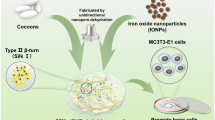Abstract
This work aimed to investigate tissue responses and biodegradation, both in vitro and in vivo, of four types of Bombyx mori Thai silk fibroin based-scaffolds. Thai silk fibroin (SF), conjugated gelatin/Thai silk fibroin (CGSF), hydroxyapatite/Thai silk fibroin (SF4), and hydroxyapatite/conjugated gelatin/Thai silk fibroin (CGSF4) scaffolds were fabricated using salt-porogen leaching, dehydrothermal/chemical crosslinking and an alternate soaking technique for mineralization. In vitro biodegradation in collagenase showed that CGSF scaffolds had the slowest biodegradability, due to the double crosslinking by dehydrothermal and chemical treatments. The hydroxyapatite deposited from alternate soaking separated from the surface of the protein scaffolds when immersed in collagenase. From in vivo biodegradation studies, all scaffolds could still be observed after 12 weeks of implantation in subcutaneous tissue of Wistar rats and also following ISO10993-6: Biological evaluation of medical devices. At 2 and 4 weeks of implantation the four types of Thai silk fibroin based-scaffolds were classified as “non-irritant” to “slight-irritant”, compared to Gelfoam® (control samples). These natural Thai silk fibroin-based scaffolds may provide suitable biomaterials for clinical applications.







Similar content being viewed by others
References
Meinel L, Fajardo R, Hofmann S, Langer R, Chen J, Snyder B, Novakovic GV, Kaplan DL. Silk implants for the healing of critical size bone defects. Bone. 2005;37:688–98.
Wang Y, Kim HJ, Novakovic GV, Kaplan DL. Stem cell-based tissue engineering with silk biomaterials. Biomaterials. 2006;37:6064–82.
Meinel L, Hofmann S, Karageorgiou V, Heade CK, McCool J, Gronowicz G, Zichner L, Langer R, Novakovic GV, Kaplan DL. The inflammatory responses to silk films in vitro and in vivo. Biomaterials. 2005;26:147–55.
Vepari C, Kaplan DL. Silk as a biomaterial. Prog Polym Sci. 2007;32:991–1007.
Kim HJ, Kima UJ, Novakovic GV, Min BH, Kaplan DL. Influence of macroporous protein scaffolds on bone tissue engineering from bone marrow stem cells. Biomaterials. 2005;26:4442–52.
Chamchongkaset J, Kanokpanont S, Kaplan DL, Damrongsakkul S. Modification of Thai silk fibroin scaffolds by gelatin conjugation for tissue engineering. Adv Mater Res. 2008;55–57:685–8.
Vachiraroj N, Ratanavaraporn J, Damrongsakkul S, Pichyangkura R, Banaprasert T, Kanokpanont S. A comparison of Thai silk fibroin-based and chitosan-based materials on in vitro biocompatibility for bone substitutes. Int J Biol Macromol. 2009;45(5):470–7.
ISO10993-6. Biological evaluation of medical devices—part 6: tests for local effects after implantation.
Kim UJ, Park J, Kim HJ, Wada M, Kaplan DL. Three-dimensional aqueous-derived biomaterial scaffolds from silk fibroin. Biomaterials. 2005;26:2775–85.
Tagchi T, Kishida A, Akashi M. Hydroxyapatite formation on/in poly(vinyl alcohol) hydrogel matrices using a novel alternate soaking process. Chem Lett. 1998;711–712.
Li M, Ogiso M, Minoura N. Enzymatic degradation behavior of porous silk fibroin sheets. Biomaterials. 2003;24:357–65.
Petrini P, Parolari C, Tanzi MC. Silk fibroin-polyurethane scaffolds for tissue engineering. J Mater Sci Mater Med. 2001;12:849–53.
Lehle K, Lohn S, Reinerth GU, Schubert T, Preuner GJ, Birnbaum DE. Cytological evaluation of the tissue-implant reaction associated with subcutaneous implantation of polymers coated with titaniumcarboxonitride in vivo. Biomaterials. 2004;25:5457–66.
Dykstra JM. A manual of applied techniques for biological electron microscopy. Drying samples with hexamethyldisilazane. New York: Plenum; 1993. p. 109.
Ozeki M, Tabata Y. In vivo degradability of hydrogels prepared from different gelatins by various cross-linking methods. J Biomater Sci Polym Ed. 2005;16:549–61.
Everaerts F, Torrianni M, Hendriks M, Feijen J. Biomechanical properties of carbodiimide crosslinked collagen: influence of the formation of ester crosslinks. J Biomed Mater Res A. 2008;85(2):547–55.
Kim HJ, Kim JU, Kim SH, Li C, Wada M, Leisk GG, Kaplan DL. Bone tissue engineering with premineralized silk scaffolds. Bone. 2008;42:1226–34.
Chunling D, Jun J, Yucheng L, Xiangdong K, Kemin W, Juming Y. Novel silk fibroin/hydroxyapatite composite films: structure and properties. Mater Sci Eng. 2009;C29:62–8.
Wang L, Nemoto R, Senna M. Microstructure and chemical states of hydroxyapatite/silk fibroin nanocomposites synthesized via a wet-mechanochemical route. J Nanopart Res. 2002;4:535–40.
Furuzono T, Taguchi T, Kishida A, Akashi M, Tamada Y. Preparation and characterization of apatite deposited on silk fabric using an alternate soaking process. J Biomed Mater Res. 2000;50:344–52.
Zhuang H, Zheng JP, Gao H. In vitro biodegradation and biocompatibility of gelatin/montmorillonite-chitosan intercalated nanocomposite. J Mater Sci Mater Med. 2007;18:951–7.
Pek YS, Spector M, Yannas IV, Gibson LJ. Degradation of a collagen-chondroitin-6-sulfate matrix by collagenase and by chondroitinase. Biomaterials. 2004;25:473–82.
Barbani N, Lazzeri L, Lelli L, Bonaretti A, Seggiani M, Narducci P, Pizzirani G, Giusti P. Physical and biological stability of dehydro-thermally crosslinked collagen-poly(vinyl alcohol) blends. J Mater Sci Mater Med. 1994;5:882–6.
Acknowledgments
The financial supports from the 90th Anniversary of Chulalongkorn University Fund (Ratchadaphiseksomphot Endowment Fund), Chulalongkorn University Centenary Academic Development Project and National Research Council of Thailand are highly acknowledged. H.T. also thanks Polymer Engineering Laboratory, Biomedical Engineering Laboratory (Faculty of Engineering), and i-Tissue Laboratory (Faculty of Medicine), Chulalongkorn University for the support of laboratory facilities.
Author information
Authors and Affiliations
Corresponding author
Rights and permissions
About this article
Cite this article
Tungtasana, H., Shuangshoti, S., Shuangshoti, S. et al. Tissue response and biodegradation of composite scaffolds prepared from Thai silk fibroin, gelatin and hydroxyapatite. J Mater Sci: Mater Med 21, 3151–3162 (2010). https://doi.org/10.1007/s10856-010-4159-5
Received:
Accepted:
Published:
Issue Date:
DOI: https://doi.org/10.1007/s10856-010-4159-5




